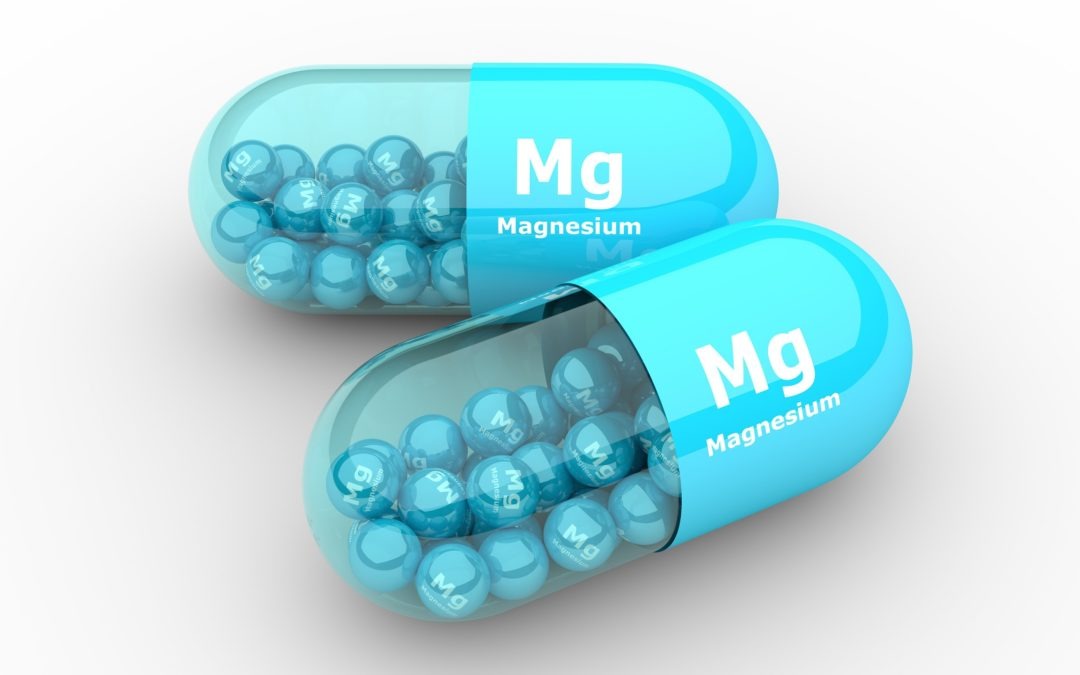The mineral magnesium (mag) is essential in over 325 enzyme reactions in the body.1 It is used to regulate blood glucose levels in the body, and help prevent you from developing diabetes.2 Mag relaxes arteries that carry blood throughout the body, which lowers blood pressure. Mag also chelates extra calcium in the body keeping the arteries from hardening due to excess calcium. The mineral is also vital for vitamin D utilization. Magnesium reduces muscle cramps and spasms and improves exercise recovery. In addition, supplementation can help lower cortisol levels, reduce anxiety, and improve your sleep. Finally, mag reduces the adverse effects of elevated ammonia on the brain and excess glutamic acid, reducing excitability and seizures.3
Possible Symptoms of A Mag Deficiency
The following is a list of possible symptoms a patient might have if they have a deficiency of the mineral. You can still have a deficiency and not have any of the following symptoms. Asymptomatic deficiency often occurs in younger people (young age helps reduce the symptoms of a deficiency), and it can also depend on the gender (men tend to have fewer symptoms than women). Most people should supplement with 400 milligrams (mg) of elemental magnesium (as long as their kidney function is normal) even if they do not know if they are deficient.4
- Tingling in legs – mag deficiency is one of the leading causes of restless legs syndrome
- Muscle cramps (charlie horse in the legs are one example)
- Weakness
- Asthma
- Elevated blood pressure and/or pulse
- Heart disease
- Diabetes
- Dizziness
- Tremors
- Irregular heartbeat (palpitations)
- Migraines
- Anxiety
- Insomnia (trouble sleeping)
- Seizure disorders
- Fatigue
- Brain fog
- Poor cognitive health
- Constipation5
Diagnostic Tests for Magnesium Deficiency
Here is a simple guide of the different tests that are used to determine if you have a mag deficiency.
Magnesium Serum Test
A magnesium serum test is the most common test performed and also the most inaccurate. Less than one percent of the body’s total magnesium is in the blood plasma, and the body does whatever it can to keep that amount in homeostasis. If you test low on a plasma test, then you are in dire need of mag, and you are deficient in your bones, organs, and muscles.6 A serum test is used to measure extracellular magnesium levels. Normal plasma levels are 1.6 – 2.4 mEq/L. 7 A serum test does not accurately measure the body’s total level but is the test most often used for diagnostic testing.
Magnesium Red Blood Cell Test
A magnesium RBC test is a more accurate test that quantifies the amount of mag stored in the red blood cells. An RBC test measures intracellular mag levels and gives you the amount that has been stored in your red blood cells for the past four months. Results of six mg/dl or higher indicate strong reserves in the body.8
Magnesium White Blood Cell Test
A magnesium WBC test is more accurate than the RBC test. Like the RBC test, the WBC test also measures intracellular magnesium levels. A mag WBC test gives you the amount that is currently in your cells; it does not show an average in the cells over a period of time like the RBC test. Sadly this test is not available to many doctors or diagnostic labs.9
Magnesium EXA Test
A magnesium EXA test is the best test to determine magnesium deficiency. The EXA test is performed by scraping your cheek buccal cells for a sample so that levels stored in your cells, bones, and muscles can be determined. Like the WBC test, the EXA test is considered an intracellular test. The EXA test will account for 99% of the body’s total mag and is the most accurate diagnostic test available to determine deficiency.10
Magnesium and Your Digestive Health
Magnesium is used in the body to help active digestive enzyme reactions in your body as well as regulate the proper transit time of your bowels.11 12 The enzyme reactions in your body help further break down fats, proteins, and carbohydrates. Mag chloride can help maintain proper stomach acid production to help assimilate food better if you have digestion problems it might be the type you want to use.13 Many forms of mag increase stomach pH so they should be taken before bed (except for possible magnesium malate, which improves bile flow) so digestive problems do not occur.
Mag is used in your intestines as an osmotic laxative.14 This means that your large intestine uses it to bring in water into the bowl so that your stool becomes softer and easier to pass which is why supplementation is a great treatment for someone who has constipation issues.15 Magnesium is very important for optimal digestive and overall health.
Different Chelations of Mag
There are many different mag chelations available for supplementation, and there is not one recommended form of magnesium for everyone. For example, if you want more energy, then you might want to supplement with mag malate. If you wish to improve upper gut digestion, then mag malate (helps improve bile flow) or mag chloride (helps produce more stomach acid) might be beneficial. Finally, mag glycinate might be a good form if you want to improve your sleep and give you a sense of calm. As you can read many different types of magnesium can help improve your health. So what are the differences in the many mag forms used for supplementation?
Recommended Chelations:
- Magnesium glycinate – The most bio-available form of mag. The extra glycine as an amino acid can help with sleep (reduction in body temperature) and provide a calm feeling. Glycine also increases LES pressure, helping to prevent reflux. This form is the least likely to cause loose stools. Taken at bedtime.16
- Magnesium malate – Magnesium malate is important for people who have a lot of fatigue or have chronic fatigue syndrome. Mag supplementation increases ATP (adenosine triphosphate), which is a molecule that provides cellular energy. Malic Acid has been shown to increase ATP levels. The chelation should be taken during the day with meals. The extra malic acid helps with bile production, may help people with gallbladder issues.17
- Magnesium chloride – Magnesium chloride is one of the best forms of mag if you are suffering from digestive issues caused by low stomach acid. It must be taken with food because the extra chloride will help produce more HCL in the stomach. Can also be used topically as a spray for transdermal supplementation.18
- Magnesium taurate – Magnesium taurate is a lifesaver for people with heart disease. Taurine is an amino acid that aids in proper heart function. Taken at bedtime.19
- Magnesium sulfate – Honestly it is only used to stop pre-eclampsia and in bath salts such as Epsom salt. Has okay absorption through the skin and also contains sulfur. Sulfate can help heal muscle sprains better than most other forms of magnesium because of skin permeability. Taken either soaking in a bath or orally before bed.20
- Magnesium arginate – Arginine is a vasodilator amino acid that is good for increasing blood flow. Increase arginine rarely can cause or worsen viral reactivation, so those prone to Herpes reactivation should avoid it in excess.21 This form is very good for bodybuilders. Taken with meals throughout the day due to the possibility of increased energy.
- Magnesium lysinate – A good source of magnesium and the amino acid lysine. Lysine is an excellent anti-viral against the Herpesviridae family. Taken before bed.22
- Magnesium ascorbate – A good source of magnesium and vitamin C. Can cause some loose stools. Taken with meals.23
- Magnesium ZMK– A great form of magnesium that is chelated from components of the Krebs cycle: citrate, fumarate, malate, succinate & alpha-keto-glutarate. The supplement form known as mag ZMK is great for athletes and is very good for workout recovery. A ZMK supplement should be taken before bed.
- Magnesium fumarate, succinate, alpha-keto glutarate – See ZMK, all Krebs cycle forms.24
- Magnesium gluconate – A form of magnesium that is chelated with gluconic acid, which occurs from the fermentation of glucose. It has above average absorption in the body (better than even mag citrate),25 rarely causes loose stools. Taken before bed.
- Magnesium carbonate – This is probably the lowest form of magnesium I can recommend. Has one of the lowest levels of assimilation and is a good osmotic laxative. It can also lower stomach acid levels and is used in most antacids. Taken at bedtime.26
Special Use Chelations:
- Magnesium orotate – This is one least known forms of magnesium, but let me tell you if you just had a surgery or exercise constantly then it will be your godsend. The extra orotate will help muscle regeneration and recovery time in athletes.27 It also has been shown to support heart health greater than even taurate. Taken at bedtime.28
- Magnesium L-threonate – Magnesium L-threonate may greatly increase mag concentrations in the brain and spinal column for improved cognitive function.29 But there is not a lot of in vivo research to prove if this is true yet though. L-threonate is an isomer of ascorbic acid.30 New research has shown that it increases mag levels about the same as the sulfate chelated, granted sulfate is generally given by IV which makes it easier to cross the blood-brain barrier than oral supplementation).31 Taken at bedtime.
- Magnesium 2-AEP – This is a form of magnesium that is chelated with phosphorylethanolamine that is a vital component of the structure and integrity of cell membranes. Mag 2-AEP has been theorized to help patients with MS because it can help with cellular function and integrity and can help protect myelin in the brain. Taken with meals during the day.32
- Magnesium peroxide – ONLY AS COLON CLEANSER. Taken before bed.
- Magnesium Phos 6X – Normally I do not recommend homeopathic supplements (if they work for some people I am glad they do, I rather recommend nutraceuticals), but for homeopathic minerals I feel they still can be beneficial because some of the trace mineral should be left in the product. I would suggest using it in a person who is extremely sensitive to all forms of supplementation. If other forms of mag cause sensitivity reactions then this is the form for you to try.33 This mag contains some phosphorus so I would suggest if you have kidney problems to stay away from this form. Taken before bed.34
Chelations to Avoid:
Most of these forms I would avoid because they either do damage in the body or are very poorly absorbed.
- Magnesium yeast chelate – A “natural” form that is very easily assimilated by the body, what could be wrong? This form is found in most of your “natural” vitamins like New Chapter, Garden of Life, and Megafood. The main problem I have with this form is that you have to ingest a lot of brewers yeast (which some people are sensitive to) in the whole supplement to get a tiny amount of mag.35 Most vitamins that use this form have very little mag in the multivitamin (less than 100 milligrams elemental). There are many better options available to improve your health. Taken with food.
- Magnesium aspartate – Absorption is not worth the extra aspartic acid. Too much, aspartic acid can be neurotoxic. Can you say ASPARTAME? Taken at bedtime. This includes ZMA supplements.36
- Magnesium pidolate – Absorption is DEFINITELY not worth the extra free glutamic acid. Too much, free glutamic acid can be excitotoxic and neurotoxic. Can you say MSG? Taken with meals.
- Magnesium hydroxide – Not greatly absorbed and most of it is released into the bowels. Most commercial preparations have sodium hypochlorite added (bleach). Taken at Bedtime.37
- Magnesium oxide – VERY POORLY ABSORBED – Out of 400 mg AT MOST 80 mg of elemental magnesium is absorbed by the body. Oxide is one of the worst absorbed forms of magnesium, and sadly the most common supplement form taken. Taken at bedtime.38
- Magnesium glycerophosphate – This form is chelated with phosphorus. The problem with this form is that most people get too much phosphate in their diet. People with kidney problems should also stay away from this supplement because it is harder for them to eliminate excess phosphates. Taken at bedtime.39
- Magnesium citrate – Magnesium citrate should mostly only be used for bowel irrigation; it is also one of the most well-known forms of supplementation. It causes some loose stools, and it has average absorption. I do not recommend mag citrate anymore because it may interfere with ceruloplasmin production.40
- Magnesium lactate – Extra lactic acid is FUN! Should not be used in people who have kidney disease because the extra lactic acid can cause complications for the kidneys. I do not recommend this form at all. Taken during meals.
Common Magnesium Amounts in Food
Magnesium needs to be supplemented because even if you eat a perfect diet, you would still have to eat a ton of nuts, brown rice, avocados, and spinach to keep from developing a deficiency. To get around four hundred milligrams daily you would have to eat one cup of cooked spinach (one hundred and fifty seven milligrams), one ounce of pumpkin seeds (one hundred and fifty milligrams), one avocado (fifty six milligrams), and one cup of cooked brown rice (eighty six milligrams) daily on average (four hundred and forty nine milligrams of mag total).41 These amounts also do not take into account the magnesium bonded to phytic acid in the pumpkin seeds, in the brown rice,42 and individual intestinal absorption of magnesium43 for different people.
To be conservative, let us say that after someone ate all this magnesium-rich food, they only absorbed three hundred milligrams of magnesium from the food. Imagine ingesting one thousand milligrams of magnesium daily from only your food intake. You would have to consume three cups of cooked spinach, three ounces of pumpkin seeds, three avocados, and three cups of brown rice throughout the day. That is a lot of food to consume in a day!
Some people have argued that magnesium supplementation is unnecessary and can be obtained through the diet. Why do we need to supplement it at all or in large amounts if we can get enough magnesium from our food? One of their biggest arguments is that ancient man survived without mag deficiencies. I have developed a few theories to answer this argument. One of those theories is that the water ancient man consumed had a higher magnesium concentration. Because water used to have a greater magnesium concentration, so did the plants, nuts, and animal meat/bones that ancient man consumed in their diet. Also, ancient man was under less stress than modern man. Their bodies did not waste as much magnesium and were able to hang on to more magnesium on a cellular level.
The amount of magnesium we absorb by the food we eat or even supplementation requires a healthy digestive system. If you suffer from poor digestion, the amount of magnesium you absorb from food will be inferior. Eat magnesium rich food, like spinach, avocado, and pumpkin seeds, while supplementing with magnesium.
Amount of Magnesium Per Serving in Certain Foods:44
The foods with the lowest calcium are in bold, but some sources may be high in phytates, which would decrease mag absorption.
- Rice bran – 1/2 cup (450 milligrams[mg])
- Cashews – four ounces (332 mg)
- Hemp seeds – three tablespoons (195 mg)
- Raw pumpkin seeds – 1/4 cup (191 mg)
- Dark chocolate (the darker the chocolate, the higher the magnesium level) – four ounces (164 mg)
- Spinach – one cup cooked (157 mg)
- Swiss chard – one cup cooked (151 mg)
- Wild rice – 1/2 cup cooked (141 mg)
- Sesame seeds – 1/4 cup (126 mg)
- Almonds – 1/2 cup (125 mg)
- Halibut – four ounces (121 mg)
- Black beans – one cup cooked (120 mg)
- Sunflower seeds – 1/4 cup (114 mg)
- Brown rice – one cup cooked (84 mg)
- Tuna – four ounces (73 mg)
- Scallops – four ounces (62 mg)
- Pecans – 1/2 cup (60 mg)
- Walnuts – 1/2 cup (60 mg)
- Avocado – one cup (42 mg)
- Cacao powder – one tablespoon (27 mg)
- Shrimp – four ounces (28 mg)
- Broccoli – one cup (19 mg)
- Cucumber – one cup (14 mg)
Phytic acid is a dihydrogen phosphate ester of inositol found in many plants that can bind with the dietary minerals we ingest and hinder their absorption. Because of phytic acid, magnesium might not be as bioavailable when consuming foods containing it, including beans, nuts, and seeds. For example, pumpkin seeds are high in magnesium, but the magnesium binds to the phytic acid, which blocks its absorption.
Elemental Magnesium
The supplementation dosage suggested in this chapter pertains to elemental magnesium. A supplement will usually have both the total amount of magnesium and the amount of its chelation on the front of the supplement. The elemental magnesium amount is found on the nutrition label. Elemental magnesium is the amount of actual magnesium you are getting when you take a supplement.45
If the front of the supplement claims that four capsules are two thousand milligrams of magnesium malate, and the back of the supplement states that you are getting four hundred milligrams of magnesium, the four hundred milligrams is the elemental amount of magnesium you will assimilate from the supplement. You also receive one thousand six hundred milligrams of malic acid when you ingest the supplement. So out of those two thousand milligrams of magnesium malate, one thousand six hundred milligrams are made up of malic acid, and the other four hundred milligrams of it is elemental magnesium.
Oral Magnesium Supplementation
Magnesium has an alkaline pH, which may slightly increase or decrease depending on its chelation. For this reason, I have individually listed the different forms of magnesium and if they should be taken before bed or with a meal. Most types of magnesium should be taken before bed because you do not want to increase the pH of the stomach during eating. There are a few forms, however, that, even though they are alkaline, seem to improve digestion, including magnesium malate or magnesium chloride, and they should be ok to be taken with meals.46
The general magnesium protocol for someone that weighs between one and two hundred pounds:47
- Elemental magnesium – eight hundred milligrams for four to six months. Then, six hundred milligrams daily after that.
If you weigh less than one hundred pounds:
- Elemental magnesium – six hundred milligrams for two months. Then, four hundred milligrams daily after that.
The above recommendation differs from the optimal amount of magnesium that anyone should take daily, but it is an average recommendation for you to follow.
The amount of magnesium you should supplement depends on your weight. The average basis for good mag cellular saturation is between ten to fourteen milligrams per kilogram daily.48 The ideal magnesium intake if you weigh around two hundred pounds is about one thousand milligrams to one thousand four hundred milligrams of elemental magnesium daily for about four to six months until their magnesium levels are balanced. This number should be increased by two hundred milligrams when you are dealing with more stress.
If you have loose stools at high levels of supplementation, you should switch to supplementing with magnesium glycinate. If you continue to have loose stools with only glycinate supplementation, you might need a mix of oral and transdermal to help increase your magnesium levels. Finally, if you are still having issues with magnesium sensitivity, then a homeopathic magnesium supplement might be needed (follow the supplement instructions; the dosage of this supplement is not dependent on weight).49
Magnesium supplementation must be monitored if you are suffering from kidney disease since proper kidney function is necessary to excrete excess magnesium. People suffering from advanced kidney disease waste magnesium greatly, and supplementation may be needed, but it needs to be monitored by a healthcare professional.50
Transdermal Magnesium Supplementation
Transdermal magnesium can be essential if you want to raise the plasma levels of magnesium and oral supplementation is not working. There is a debate right now whether oral magnesium supplementation or transdermal magnesium supplementation is the best to increase your magnesium levels. Some studies show that transdermal magnesium does not work well because magnesium is unable to penetrate the skin very easily. Soaking in water to open up the tight skin junctions, like in an Epsom salt bath, might increase transdermal absorption. Taking Epsom salt baths twice daily can be one way to increase transdermal supplementation51
Another way to get transdermal magnesium is to use a magnesium gel like MagneGel. MagneGel delivers approximately one hundred and fifty milligrams of elemental magnesium per one-fourth teaspoon to the skin. I suggest applying nine hundred to twelve hundred milligrams of transdermal magnesium daily for about four months. You can base the transdermal supplementation guidelines on the oral weight recommendations above. If you weigh more than two hundred pounds, you will need to increase the amount you supplement52
Both Oral And Transdermal Supplementation
Another option is to use both oral and transdermal supplementation. If you weigh close to two hundred pounds, I would take six hundred milligrams of elemental oral magnesium daily and use MagneGel once or twice daily. This way, you would get around one thousand to one thousand and four hundred milligrams of total magnesium intake a day. Follow this regimen for four months and then retest magnesium levels. Using both transdermal magnesium and oral magnesium may reduce oral absorption; therefore, it is essential to increase oral supplementation during the protocol.
Magnesium Recommendation Dosages Based On Weight and Sex Recommendations
Remember, the amount of magnesium you should supplement depends on your weight. The basis for good magnesium cellular saturation is fourteen milligrams per kilogram daily.
All these magnesium-dose recommendations are for someone that weighs roughly two hundred pounds (one thousand to one thousand and four hundred milligrams daily). If you only weigh a hundred pounds, I would divide the total magnesium intake to around six hundred to eight hundred milligrams daily to increase magnesium levels. If you weigh more than three hundred and fifty pounds, you might want to increase your daily magnesium intake to about one thousand and eight hundred to two thousand two hundred milligrams daily if you have normal kidney function.
Women should increase their magnesium by about one hundred and fifty to two hundred milligrams daily when menstruating. Women who are pregnant might want to go more conservative on their dosages and take no more than six hundred milligrams daily for safety.
Building Magnesium Levels, When to Test, and Maintenance Dosage
Before supplementing with magnesium, it is prudent to have a magnesium EXA test or a magnesium RBC test performed. If your magnesium levels are low, follow prior recommendations on how to increase them. Follow the chart below to determine how long you should supplement with magnesium.
Length of Average Magnesium Supplementation53
If your magnesium levels are normal, you should supplement elemental magnesium daily with about four hundred to six hundred milligrams daily. Even if your magnesium levels are normal, and you have a specific medical reason to increase your mag above these levels (chronic fatigue syndrome, nerve damage, and brain trauma are some examples), you should be fine to increase supplementation if you have adequate kidney function. You will need to get your mag levels frequently tested (every two to three months) to ensure hypermagnesemia does not occur. Finally, if your magnesium levels are deficient, intravenous magnesium supplementation might be needed on an emergency basis.54
Hypermagnesemia
Hypermagnesemia is a rare condition in which a person has too much magnesium in their blood plasma. Hypermagnesemia usually does not occur in people that take supplemental magnesium, but it can occur if the person has impaired kidney function. Intravenous magnesium bypasses the body’s digestion entropy and has a greater chance of leading to overdose. In vivo, the body has many mechanisms in place to prevent a magnesium overdose.55
Diagnostic symptoms are usually a combination of low blood sugar and elevated serum calcium. Symptoms usually include weakness, vomiting, impaired breathing, hypotension, increased blood calcium levels, arrhythmia, lack of muscle reflexes, and bradycardia (slow heart rate). It is possible that if one’s plasma magnesium level is too high the heart can stop, causing sudden cardiac death. Magnesium is a muscle relaxant, but this outcome is extremely rare.56
Treatment for hypermagnesemia includes giving intravenous calcium gluconate to inactivate free magnesium through a binding process. Calcium also reactivates the muscle cells because calcium is a muscle activator. Finally, dialysis might be needed in some cases to eliminate excess magnesium, and to help with kidney function.57
Brands of Magnesium I Recommend
Recommended Magnesium Glycinate Supplements:
Other Recommendations:
Recommended Magnesium Malate Supplements:
Other Recommendations:
Recommended Magnesium Citrate Supplements:
Other Recommendations:
Recommended Magnesium Gluconate Supplement:
Recommended Magnesium Chloride Supplement:
Other Recommendation:
Recommended Magnesium Peroxide Supplement:
Recommended Magnesium Ascorbate Supplements:
Recommended Magnesium Orotate Supplement
Recommended Magnesium Taurate Supplement:
Recommended Transdermal Magnesium:
Other Recommendation:
Recommended Magnesium Sulfate:
Recommended Magnesium 2-AEP Supplement:
Recommended Magnesium Arginate Supplement:
- Advanced Research magnesium arginate with aspartate (It is the only magnesium arginate I know of, but it does have magnesium aspartate in the supplement, so use the supplement sparingly)
Recommended Magnesium Lysinate Supplement:
Recommended Magnesium L-Threonate Supplements:
Other Recommendation:
Recommended Magnesium Deodorant:
- http://www.naturalnews.com/023511_magnesium_body_deficiency.html ↩
- http://www.drsircus.com/medicine/magnesium/the-insulin-magnesium-story-2 ↩
- Dean, Carolyn. The Magnesium Miracle, Ballantine Books, December 26, 2006. ↩
- http://www.huffingtonpost.com/christiane-northrup/magnesium-calcium_b_509115.html ↩
- http://umm.edu/health/medical/altmed/supplement/magnesium ↩
- http://www.lef.org/news/LefDailyNews.htm?NewsID=17659 ↩
- http://www.healthline.com/health/serum-magnesium-test ↩
- http://drcarolyndean.com/2010/06/gauging-magnesium-deficiency-symptoms ↩
- http://otiswoodardmd.typepad.com/my_weblog/2009/04/magnesium-do-you-have-enough.html ↩
- http://www.exatest.com ↩
- http://www.naturalnews.com/023511_magnesium_body_deficiency.html ↩
- http://www.natural-indigestion-relief.com/magnesium-and-constipation.html ↩
- http://drsircus.com/medicine/magnesium/magnesium-chloride-benefits ↩
- http://www.ncbi.nlm.nih.gov/pubmed/21094173 ↩
- http://steveclarknd.com/?page_id=201 ↩
- http://afibbers.org/resources/magnesiumabsorption.pdf ↩
- Dean, Carolyn. The Magnesium Miracle, Ballantine Books, December 26, 2006. ↩
- http://drsircus.com/medicine/magnesium/magnesium-chloride-benefits ↩
- Dean, Carolyn. The Magnesium Miracle, Ballantine Books, December 26, 2006. ↩
- http://www.westonaprice.org/vitamins-and-minerals/magnificent-magnesium ↩
- Balch, Phyllis. Prescription for Nutritional Healing, Avery Publishing, 2010. ↩
- Balch, Phyllis. Prescription for Nutritional Healing, Avery Publishing, 2010. ↩
- Balch, Phyllis. Prescription for Nutritional Healing, Avery Publishing, 2010. ↩
- Dean, Carolyn. The Magnesium Miracle, Ballantine Books, December 26, 2006. ↩
- http://www.ncbi.nlm.nih.gov/pubmed/16548135 ↩
- http://articles.mercola.com/sites/articles/archive/2012/12/17/magnesium-benefits.aspx ↩
- http://www.globalhealingcenter.com/calcium-orotate/orotates-mineral-transporters ↩
- http://www.harshachemicals.com/MagnesiumOrotateStudy.htm ↩
- http://www.lef.org/magazine/mag2012/abstracts/feb2012_Magnesium-L-Threonate_01.htm ↩
- http://www.annualreviews.org/doi/abs/10.1146/annurev.nu.06.070186.002053 ↩
- http://www.ncbi.nlm.nih.gov/pubmed/15753761 ↩
- Nieper, Hans. The Curious Man: The Life and Works of Dr. Nieper, Avery, December 1, 1998 ↩
- Dean, Carolyn. The Magnesium Miracle, Ballantine Books, December 26, 2006. ↩
- http://www.kidney.org/atoz/content/phosphorus.cfm ↩
- http://www.debralynndadd.com/_blog/toxicfreenutrition/post/when-wholefood-vitamins-arent-made-from-actual-foods/ ↩
- Dean, Carolyn. The Magnesium Miracle, Ballantine Books, December 26, 2006. ↩
- Dean, Carolyn. The Magnesium Miracle, Ballantine Books, December 26, 2006. ↩
- Dean, Carolyn. The Magnesium Miracle, Ballantine Books, December 26, 2006. ↩
- http://www.kidney.org/atoz/content/phosphorus.cfm ↩
- Dean, Carolyn. The Magnesium Miracle, Ballantine Books, December 26, 2006. ↩
- http://www.whfoods.com/genpage.php?tname=nutrient&dbid=75 ↩
- http://chriskresser.com/another-reason-you-shouldnt-go-nuts-on-nuts ↩
- http://articles.mercola.com/sites/articles/archive/2012/12/17/magnesium-benefits.aspx ↩
- http://www.whfoods.com/genpage.php?tname=nutrient&dbid=75 ↩
- http://ods.od.nih.gov/factsheets/Magnesium-HealthProfessional/ ↩
- Dean, Carolyn. The Magnesium Miracle, Ballantine Books, December 26, 2006 ↩
- Dean, Carolyn. The Magnesium Miracle, Ballantine Books, December 26, 2006 ↩
- http://ajcn.nutrition.org/content/14/6/342.short ↩
- Dean, Carolyn. The Magnesium Miracle, Ballantine Books, December 26, 2006 ↩
- http://ckj.oxfordjournals.org/content/5/Suppl_1/i39.full ↩
- Sircus, Mark / Reid, Daniel. Transdermal Magnesium Therapy, Phaelos Books & Mediawerks, January 1, 2007. ↩
- http://www.rockwellnutrition.com/MagneDerm-Transdermal-Magnesium-Gel-by-Designs-for-Health-DFH.html ↩
- Dean, Carolyn. The Magnesium Miracle, Ballantine Books, December 26, 2006 ↩
- http://emj.bmj.com/content/19/4/288.full ↩
- http://emedicine.medscape.com/article/246489-overview ↩
- http://www.uptodate.com/contents/symptoms-of-hypermagnesemia ↩
- http://circ.ahajournals.org/content/112/24_suppl/IV-121.full ↩







Hi, John!
This was such a good article. It’s fascinating to see how many symptoms magnesium deficiency can cause. I’m also glad that you mentioned that it’s not possible to get all of the magnesium you need from diet alone and that supplementation is needed.
what do you know already or nothing yet ”
about mag glycinate ionized
and cis 16 cis 18 magnesium ?
https://www.amazon.com/PERQUE-Plus-Guard-Vegetable-Capsules/dp/B001EBK3DI
Magnesium hydroxide – Not greatly absorbed and most of it is released into the bowels. Most commercial preparations have sodium hypochlorite added (bleach). Taken at Bedtime
is this when been isolated similar to usp in vitamins
or as well when in form of whole food like hydrilla and red marine algae
and been filtered to get higher amount of it available
??
Angstrom Magnesium starts out as magnesium chloride. The angstrom process removes the chloride and leaves magnesium bonded to reverse osmosis water.
3. What form is Angstrom Magnesium?
Angstom Magnesium is a liquid form and is absorbed on the cellular level. Cellular absorption helps bypass the digestive tract. By absorbing into the cell, the effects of too much magnesium in the intestine are minimized. Thus, Angstrom Magnesium does not cause diarrhea at elevated doses.
magnesium stearate provides edible elemental dietary magnesium ?
how about electronically enhanced ionic magnesium ?
and how about magnesium out of hydrilla and Lithothamnium calcareum Coralline algae ?
is that the same/similar to magnesium b-hydroxybutyrate
Magnes Res. 2019 Feb 1;32(1):16-24. doi: 10.1684/mrh.2019.0454.
Magnesium and the blood-brain barrier in vitro: effects on permeability and magnesium transport.
Romeo V1, Cazzaniga A1, Maier JAM1.
Author information
1
Dipartimento di Scienze Biomediche e Cliniche L. Sacco, Università di Milano, Via GB Grassi 74, 20157 Milano, Italy.
Abstract
The blood-brain barrier (BBB) tightly regulates the homeostasis of the central nervous system, and its dysfunction has been described in several neurological disorders. Since magnesium exerts a protective effect in the brain, we assessed whether supraphysiological concentrations of different magnesium salts modulate the permeability and magnesium transport in in vitro models of rat and human BBB. Among various formulations tested, magnesium pidolate was the most efficient in reducing the permeability and in enhancing magnesium transport through the barrier. We then compared magnesium pidolate and magnesium sulfate, a widely used salt in experimental models and in clinical practice. Magnesium pidolate performs better than sulfate also in preventing lipopolysaccharide-induced damage to in vitro generated BBB. We conclude that magnesium pidolate emerges as an interesting alternative to sulfate to protect BBB and maintain correct intracerebral concentrations of magnesium
What are your thoughts on Thorne’s Magnesium CitraMate?
I suffer from Raynaud’s disease. It sounds like vascular dilation should help with the symptoms. Any suggestion as to what is the best form of magnesium?
im thinking that i definately need the chloride due to the bloating and reflux i been feeling, but i also do crossfit and i have noticed that most of the days its difficult to sleep due my system still feeling overactive (hot blood, fast heart rate, muscle soreness,etc). with that bieng said would you recommend the zmk? I probably I am not intaking enough magnesium in my daily diet, what would u suggest?
ps…i grabbed Trace Mineral’s ionic magnesium made up of 400mg magnesium,and 1100mg chloride. you mentioned that its ideal to take about 800mg if you weigh around 200lbs,would it also apply for the ionic solution?
Maybe slightly less around 600 mg, but yes take it in divided doses if possible.
divided as in two 600 doses a day?
No, one 400 mg dose and one 1/2 dose at 200 mg.
ok, appreciate everything that you do.
Greetings John. I would appreciate you informing of where my patients can have the EXA test done.
http://www.exatest.com/OrderPhysicians.htm
Magnesium ZMK vs glycinate which assimilates better ?
alpha -ketoglutarate = ok found it in the zmk ,but still some forms you cite separate ,while others in the Krebs cycle ,are only cited as part of the zmk “?
Because I am not aware of a magnesium alpha-ketoglutarate supplement?
alpha-ketoglutarate form of magnesium not covered ?
can take even magnesium oxide along with fulvic acis ,and it will assimilate it even better then glycinae ?
Why would it? The magnesium found in fulvic acid is hydroxide. Fulvic acid is supposed to improve magnesium’s assimilation into the mitochondria, not its assimilation by the enterocytes.